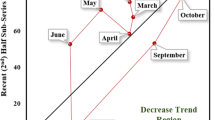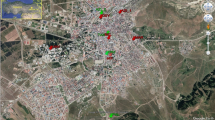Abstract
Parametric methods are commonly used to conduct the trend analysis of air pollution. These methods require certain statistical assumptions, such as stationarity and normality of the data. However, such assumptions are usually not applicable to trends in Air pollution index (API). In addition, the change points in the time series have not been taken into consideration by most of the analysis of API. Therefore, this study presents a comprehensive investigation of the trend analysis and change point detection of the mean and maximum of API series in Malaysia. The hourly, daily, weekly, monthly, seasonal, and annual API data series were considered in the analysis. The finer time intervals were used to detect any significant increasing or decreasing trends of the API series for Malaysia. The API data were collected from 37 air monitoring stations in Peninsular Malaysia. The nonparametric tests, including Mann–Kendall test, Pettitt test, and innovative trend analysis were used to examine the contribution presented herein. Various aspects of API data were studied, including upward trends, downward trends, and change points. Several significant monotonic trends and changing points in some of the API measuring stations were found from the Mann–Kendall test results. Significant increasing trends of the monthly and seasonal mean, as well as maximum API, were found in the years 2013 and 2014 for some stations. In addition, the magnitudes of the increasing trends in maximum API are larger than the mean API. The detection points captured by the Pettitt test are possibly related to the El-Nino events. In general, the results of the study provide comprehensive information on air quality trends and their atmospheric aspects, which can help in develo** strategies to address air quality problems and provide meaningful opportunities to mitigate air pollution problems in Peninsular Malaysia.











Similar content being viewed by others
References
Afroz R, Hassan MN, Ibrahim NA (2003) Review of air pollution and health impacts in Malaysia. Environ Res 92(2):71–77
Al-Dhurafi NA, Masseran N, Zamzuri ZH, Razali AM (2018a) Modeling unhealthy air pollution index using a peaks-over-threshold method. Environ Eng Sci 35(2):101–110
Ali R, Kuriqi A, Abubaker S, Kisi O (2019) Long-term trends and seasonality detection of the observed flow in Yangtze River using Mann–Kendall and Sen’s innovative trend method. Water 11(9):1855
Alyousifi Y, Ibrahim K, Kang W, Zin WZW (2021) Robust empirical Bayes approach for Markov chain modeling of air pollution index. J Environ Health Sci Eng 19(1):343–356
Alyousifi Y, Ibrahim K, Kang W, Zin WZW (2019) Markov chain modeling for air pollution index based on maximum a posteriori method. Air Qual Atmos Health 12(12):1521–1531
Alyousifi Y, Ibrahim K, Wei K, Zin WZW (2020a) Modeling the spatio-temporal dynamics of air pollution index based on spatial markov chain model. Environ Monit Assess 11(192):1–24
Alyousifi Y, Masseran N, Ibrahim K (2018) Modeling the stochastic dependence of air pollution index data. Stoch Env Res Risk Assess 32(6):1603–1611
Alyousifi Y, Othman M, Sokkalingam R, Faye I, Silva PC (2020b) Predicting daily air pollution index based on fuzzy time series markov chain model. Symmetry 12(2):293–310
Arman M, Azid A, Juahir H, Toriman M, Mustafa A, Hasnam C, Yunus K (2015) Spatial analysis of the certain air pollutants using environmetric techniques. Jurnal Teknologi 75(1):241–249
Azid A, Juahir H, Aris AZ, Toriman ME, Latif MT, Zain SM, Saudi ASM (2014) Spatial analysis of the air pollutant index in the Southern Region of Peninsular Malaysia using environmetric techniques. From sources to solution. Springer, pp 307–312
Azmi SZ, Lati MT, Ismail AS, Juneng L, Jemain AA (2010) Trend and status of air quality at three different monitoring stations in the Klang Valley, Malaysia. Air Qual Atmos Heal 9(3):53–64
AL-Dhurafi N A, Masseran N, Zamzuri Z H, (2020) Hierarchical-Generalized Pareto Model for Estimation ofUnhealthy Air Pollution Index. Environ Model Assess 15(5):1–10
Butler CD, Whelan J (2018) Air pollution and climate change in Australia: a triple burden. Climate change and air pollution. Springer, pp 131–149
Chaudhuri S, Dutta D (2014) Mann–Kendall trend of pollutants, temperature and humidity over an urban station of India with forecast verification using different ARIMA models. Environ Monit Assess 186(8):4719–4742
Dabanlı İ, Şen Z, Yeleğen MÖ, Şişman E, Selek B, Güçlü YS (2016) Trend assessment by the innovative-Şen method. Water resources management 30(14):5193–5203
Damberg L, AghaKouchak A (2014) Global trends and patterns of drought from space. Theoret Appl Climatol 117(3–4):441–448
Demir V, Kisi O (2016) Comparison of Mann-Kendall and innovative trend method (Şen trend) for monthly total precipitation. Middle Black Sea Region, Turkey
Deni SM, Suhaila J, Wan Zin WZ, Jemain AA (2010) Spatial trends of dry spells over Peninsular Malaysia during monsoon seasons. Theor Appl Climatol 99:357–371
Department of Environment Malaysia (DOE) (2000) A guide to Air Pollutant Index in Malaysia (API). Ministry of Science, Technology, and the Environment, Kuala Lumpur, Malaysia
Dominick D, Juahir H, Latif MT, Zain SM, Aris AZ (2012) Spatial assessment of air quality patterns in Malaysia using multivariate analysis. Atmos Environ 12(60):172–181
Douglas EM, Vogel RM, Kroll CN (2000) Trends in floods and low flows in the United States: impact of spatial correlation. J Hydrol 240(4):90–105
Gass K, Klein M, Sarnat S, Winquist A, Darrow L, Flanders W, Chang H, Mulholland J, Tolbert P, Strickland M (2015) Associations between ambient air pollutant mixtures and pediatric asthma emergency department visits in three cities: a classification and regression tree approach. Environ Health 7(58):1–14
Halim NDA, Latif MT, Ahamad F, Dominick D, Chung JX, Juneng L, Khan MF (2018) The long-term assessment of air quality on an island in Malaysia. Heliyon 4(12):10–54
Hirsch R, Slack J, Smith R (1982) Techniques of trend analysis for monthly water quality data. Wat Res Res 32(1):107–121
Ismail M, Suroto A, Ismail NA (2012) Time series analysis of surface ozone monitoring records in Kemaman. Malaysia. Sains Malaysiana 40(5):411–417
Jaiswal A, Samuel C, Kadabgaon VM (2018) Statistical trend analysis and forecast modeling of air pollutants. Glob J Environ Sci Manag 4(4):427–438
Jaiswal RK, Lohani AK, Tiwari HL (2015) Statistical analysis for change detection and trend assessment in climatological parameters. Environ Process 2(4):729–749
Kendall M G (1948) The advanced theory of statistics, 4th edn, vol 1
Kendall MG (1975) Rank correlation methods. Griffin
Latif MT, Azmi SZ, Noor AD, Ismail AS, Johny Z, Idrus S, Mohamed AF, Mokhtar M (2011) The impact of urban growth on regional air quality surrounding the Langat River Basin. Malaysia. Environmentalist 31(12):315–324
Maleki H, Sorooshian A, Goudarzi G, Baboli Z, Birgani YT, Rahmati M (2019) Air pollution prediction by using an artificial neural network model. Clean Technol Environ Policy 21(6):1341–1352
Mann B (1945) Nonparametric tests against trend. Econom J Econom Soc 13:245–259
Millard S P, Kowarik A, Kowarik M A (2020) Package ‘EnvStats’. version 2.2.1 http://CRAN.R-project.org
Mitchell W J (1994) The reconfigured eye: Visual truth in the post-photographic era. Mit Press
Militino AF, Moradi M, Ugarte MD (2020) On the performances of trend and change-point detection methods for remote sensing data. Remot Sens 12(6):1008
Mohtar AAA, Latif MT, Baharudin NH, Ahamad F, Chung JX, Othman M, Juneng L (2018) Variation of major air pollutants in different seasonal conditions in an urban environment in Malaysia. Geosci Lett 5(1):1–13
Motiva MI, Bielik N, Campelos PB, Cluse C, Goujon-Ginglinger CG, Jaquier A, Polier-Calame J (2019) Air quality assessment of the Tobacco Heating System 22 under simulated residential conditions. Air Qual Atmos Health 12:807–883
Nieto PG, Lasheras FS, García-Gonzalo E, de Cos Juez FJ (2018) PM10 concentration forecasting in the metropolitan area of Oviedo (Northern Spain) using models based on SVM, MLP, VARMA and ARIMA: A case study. Sci Total Environ 621:753–761
Öztopal A, Şen Z (2017) Innovative trend methodology applications to precipitation records in Turkey. Wat Resourc Manag 31(3):727–737
Pal I, Al-Tabbaa A (2009) Trends in seasonal precipitation extremes—an indicator of ‘climate change’in Kerala, India. J Hydrol 367(1–2):62–69
Patakamuri S K, O'Brien N, Patakamuri M S K (2020) Package ‘modifiedmk’. Version 1.5.0. CRAN
Pettitt AN (1979) A non-parametric approach in the change point problem. Appl Stat 28(2):126–135
Pohlert T, Pohlert MT, Kendall S (2016) Package ‘trend’. Title Non-Parametric Trend Tests and Change-Point Detection
Rahman SRA, Ismail SNS, Raml MF, Latif MT, Abidin EZ, Praveena SM (2015) The assessment of ambient air pollution trend in Klang Valley, Malaysia. World Environ 5(1):1–11
Rathnayake U (2019) Comparison of statistical methods to graphical methods in rainfall trend analysis—case studies from tropical catchments. Adv Meteorol 2019:1–10
Abd Rani NL, Azid A, Khalit SI, Juahir H, Samsudin MS (2018) Air pollution index trend analysis in Malaysia, 2010–15. Pol J Environ Stud 27(2):801–807
Salarijazi M, Akhond-Ali A, Daneshkhah Adib A, A, (2012) Trend and changepoint detection for the annual streamflowseries of the Karun River at the Ahvaz hydrometric station. African J Agricult Res 7(32):4540–4552
Sen A, Srivastava M (2012) Regression analysis: theory, methods, and applications. Springer
Sen PK (1968) Estimates of the regression coefficient based on Kendall’s tau. J Am Stat Assoc 63(324):1379–1389
Şen Z (2017) Innovative trend significance test and applications. Theoret Appl Climatol 127(4):939–947
Singh KP, Bartolucci AA, Bae S (2001) Mathematical modeling of environmental data. Mathemat Computer Model 33(6–7):793–800
Suhaila J, Deni SM, Wan Zin WZ, Jemain AA (2010) Spatial patterns and trends of daily rainfall regime in Peninsular Malaysia during the Southwest and Northeast Monsoons: 1975–2004. Meteorol Atmos Phys 110:1–18
Suhaila J, Yusop Z (2018) Trend analysis and change point detection of annual and seasonal temperature series in Peninsular Malaysia. Meteorol Atmos Phys 130(5):565–581
Tabari H, Taye MT, Willems P (2015) Statistical assessment of precipitation trends in the upper Blue Nile Riverbasin. Stochast Environ Res Risk Assess 29(7):1751–1761
Theil H (1950) A rank-invariant method of linear and polynominal regression analysis (Parts 1–3). In Ned. Akad Wetensch Proc Ser A 53:1397–1412
Tosunoglu F, Kisi O (2017) Trend analysis of maximum hydrologic drought variables using Mann–Kendall and Sen’s innovative trend method. River Res Appl 33:597–610
Von Storch H (1999) Misuses of statistical analysis in climate research. Analysis of climate variability. Springer, pp 11–26
Wang S, Zhang X (2012) Long-term trend analysis for temperature in the **sha River Basin in China. Theoret Appl Climatol 109(3):591–603
Yusof F, Hui Mean F, Suhaila J, Yusop Z (2013) Characterisation of drought properties with bivariate copula analysis. Water Resour Manag 27:4183–4207. https://doi.org/10.1007/s11269-013-0402-4
Zarenistanak M, Dhorde AG, Kripalani RH (2014) Trend analysis and change point detection of annual and seasonal precipitation and temperature series over southwest Iran. J Earth Syst Sci 123(2):281–295
Zhang Q, Streets DG, Carmichael GR, He K, Huo H, Kannari A, Klimont Z, Park I, Reddy S, Fu J (2009) Asian emissions in 2006 for the Nasa Intex-B Mission. Atmos Chem Phys 9(14):5131–5153
Zhang L, Lin J, Qiu R, Hu X, Zhang H, Chen Q, Wang J (2018) Trend analysis and forecast of PM2. 5 in Fuzhou, China using the ARIMA model. Ecol Ind 95:702–710
Acknowledgements
The authors are grateful to the Department of Environment Malaysia for their cooperation in providing the air pollution data. The authors also wish to thank the anonymous reviewers for their critical comments and views that led to the improvement of this paper and express thanks to Mr. Abdullah Al-Yaari for reviewing the manuscript.
Author information
Authors and Affiliations
Corresponding author
Ethics declarations
Conflict of interest
The authors declare that they have no conflict of interest.
Additional information
Editorial responsibility: Mohamed F. Yassin.
Supplementary Information
Below is the link to the electronic supplementary material.
Rights and permissions
About this article
Cite this article
Alyousifi, Y., Ibrahim, K., Zin, W.Z.W. et al. Trend analysis and change point detection of air pollution index in Malaysia. Int. J. Environ. Sci. Technol. 19, 7679–7700 (2022). https://doi.org/10.1007/s13762-021-03672-w
Received:
Revised:
Accepted:
Published:
Issue Date:
DOI: https://doi.org/10.1007/s13762-021-03672-w




